Are you a Quiet Speculation member?
If not, now is a perfect time to join up! Our powerful tools, breaking-news analysis, and exclusive Discord channel will make sure you stay up to date and ahead of the curve.
With Core 2020 and the London mulligan finally legal, the metagame can begin to take shape. Begin being the key word there. So much has changed in Modern over the past month that it is impossible to predict what exactly is changing.
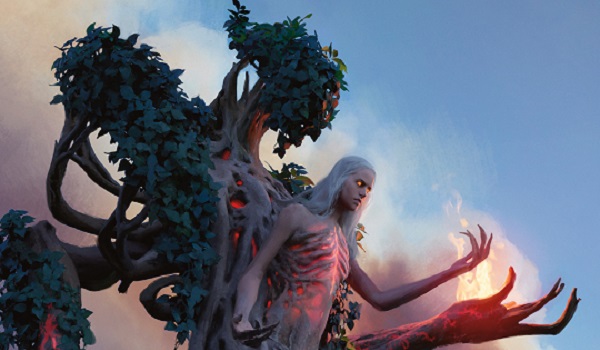
At the end of this week, GP Denver looms. I'm not playing the main event since it's Standard and I'm not interested in Teferi.format. Instead, I'm preparing for the Modern MCQ on Saturday. This has proven rather difficult due to the metagame's lack of definition. Today I'll be going through what I've observed so far and what conclusions I've reached.
Thin Data
Normally, I'd fall back on the available data to draw informed conclusions about the metagame taking shape. However, that really isn't possible. At the moment all I have to go on are a 5-0 deck dump, which has no statistical value, and a single SCG Classic. The Classic is interesting and a decent piece of data, but it is only a single point. Therefore, the only conclusions I could draw would be about the event itself and not the entire metagame.
As a result, I'm forced to rely primarily on personal observations of both my local paper metagame and what I've seen on MTGO. I realize that my experiences may not be representative. Even if they don't accurately model the entire metagame, I'm getting one look at what players are thinking. And in short, it's the Wild West out there.
Dredge Rises Again
First thing's first: I have bad news for anyone sick of graveyard decks. Dredge is back like it never left. My LGS, Black Gold, has never had many Dredge decks because we all pack lots of hate at all times, but I'm seeing plenty online. Dredge never played Bridge from Below, so it's escaped another round of bannings unscathed. The only reason it declined from view was Hogaak inhabited the same space, but was better. Now the Necropolis is gone, Dredge is reclaiming its place.
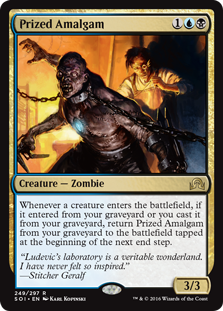 For the most part, they're all just pre-Horizons lists. Dredge has been around a while and has proven itself, so it makes sense to trot the same list out again. However, there are those who are trying to innovate. In what I've seen so far, this mainly entails trying to fit Hogaak, Arisen Necropolis into existing shells. While I think it could work, so far I haven't actually seen it happen. The opportunity cost of Hogaak is pretty high for Dredge.
For the most part, they're all just pre-Horizons lists. Dredge has been around a while and has proven itself, so it makes sense to trot the same list out again. However, there are those who are trying to innovate. In what I've seen so far, this mainly entails trying to fit Hogaak, Arisen Necropolis into existing shells. While I think it could work, so far I haven't actually seen it happen. The opportunity cost of Hogaak is pretty high for Dredge.
Others are trying to adapt Bridgevine to a Bridgeless world. While these lists have been fascinating to watch, they're significantly worse than Bridgevine, and in my experience much less consistent than Dredge. I admire the dedication, but it looks like wasted effort.
New World, Old Rules
Regardless, it's obvious that graveyard decks aren't going anywhere in Modern, so neither should your hate. I've seen way too many players cutting their hate assuming they don't need 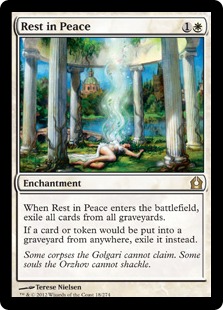 it. Never just concede the Dredge matchup, and don't forget that Surgical Extraction isn't very effective against Dredge. You'll need Tormod's Crypt or better.
it. Never just concede the Dredge matchup, and don't forget that Surgical Extraction isn't very effective against Dredge. You'll need Tormod's Crypt or better.
The other thing to remember is how to play against Dredge, especially when timing your hate. Dredge consists of a lot of enablers and a few key cards. You want to time one-shot hate to get as many of those cards as possible. Individual dredgers are bad targets; Dredge always has more. Instead, you need to target Prized Amalgam and Conflagrate. The former is the primary threat and the later is the real power card. Don't crack your Crypt unless you have to, or can get at least two of these cards.
Jund Is Back
The other big trend I've seen is that BGx is back in force. Last week, roughly half the field was some form of BGx deck. I saw similar numbers online. There was classic Bloodbraid Jund, straight Rock, control Jund, an Assault Loam/Jund hybrid, and plenty of Wrenn and Six Jund decks. This wasn't surprising; Jund's got a lot of new toys recently, a really bad matchup is gone, and lots of players have invested a lot of time and money into the deck. Of course they'll play it again.
Six Reasons Why
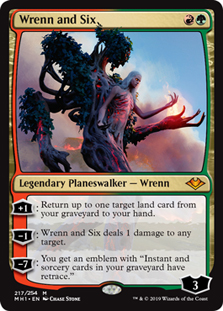 The primary reason for this resurgence is Wrenn and Six. When I reviewed it, I was unimpressed. Wrenn just didn't do enough when it wasn't standing in for Life from the Loam. I stand by that assessment and remind everyone that Wrenn does nothing against Rest in Peace, but there was something I missed.
The primary reason for this resurgence is Wrenn and Six. When I reviewed it, I was unimpressed. Wrenn just didn't do enough when it wasn't standing in for Life from the Loam. I stand by that assessment and remind everyone that Wrenn does nothing against Rest in Peace, but there was something I missed.
Never missing a land drop and thinning your deck is good. Wrenn provides that function to Jund, with a little value in killing small creatures. No cog in any machine is very good on its own, but Wrenn seems to be a cog that fits seamlessly into Jund and makes the machine run smoother.
A Catch
However, I don't know how good it actually is. Despite all their numbers (roughly a quarter of the field), no Jund deck has actually won our local tournaments in a month. I can't remember any going better than 3-1. I haven't had any greater difficulty playing against the new versions than the old ones, as the games come down to the same grind as before, making me think that the deck may not be more powerful so much as more attractive.
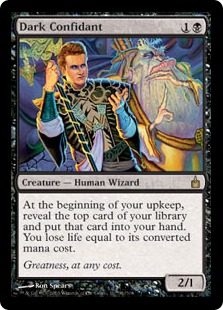 Part of this upsurge may be Legacy spillover. I'm told that Wrenn is taking over Legacy. Most Legacy creatures are X/1's, so Wrenn's downtick is very relevant, but more importantly Wrenn is great with and against Wasteland. Thanks to dual lands, the opportunity cost of just running four-color piles in Legacy is pretty low. The ubiquity of Wasteland keeps these decks in check. Wrenn undoes Wasteland, and now the piles are back. Logically, players are applying this logic to Modern and thus Jund is everywhere, hoping to replicate the Legacy success.
Part of this upsurge may be Legacy spillover. I'm told that Wrenn is taking over Legacy. Most Legacy creatures are X/1's, so Wrenn's downtick is very relevant, but more importantly Wrenn is great with and against Wasteland. Thanks to dual lands, the opportunity cost of just running four-color piles in Legacy is pretty low. The ubiquity of Wasteland keeps these decks in check. Wrenn undoes Wasteland, and now the piles are back. Logically, players are applying this logic to Modern and thus Jund is everywhere, hoping to replicate the Legacy success.
The other reason is that Wrenn plays very well with another new Jund card that definitely is as good as it seems.
Season of Grind
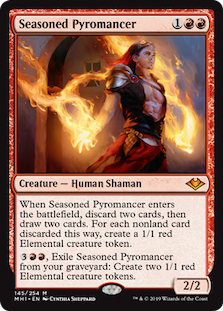 Seasoned Pyromancer is an exceptional card in any version of Jund. The 2/2 body isn't that impressive, but it doesn't matter given the card advantage it provides. I'm told, but can't verify, that Jund is cutting Dark Confidant because he's bad against Wrenn, and Bob is an investment. Pyromancer gives new cards up front, potentially with value. Obviously, discarding Wrenned-back lands is good, but turning useless discard spells into Elementals alleviates the problem of drawing the wrong part of the deck at the wrong time. He can then provide value from the graveyard. Pyromancer is a very solid card, and in my opinion, a far better reason than Wrenn to play Jund.
Seasoned Pyromancer is an exceptional card in any version of Jund. The 2/2 body isn't that impressive, but it doesn't matter given the card advantage it provides. I'm told, but can't verify, that Jund is cutting Dark Confidant because he's bad against Wrenn, and Bob is an investment. Pyromancer gives new cards up front, potentially with value. Obviously, discarding Wrenned-back lands is good, but turning useless discard spells into Elementals alleviates the problem of drawing the wrong part of the deck at the wrong time. He can then provide value from the graveyard. Pyromancer is a very solid card, and in my opinion, a far better reason than Wrenn to play Jund.
Modern Belcher
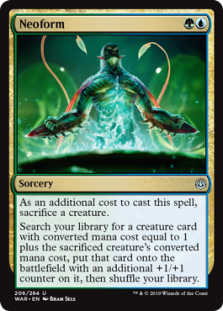 The other big trend I've seen is that Neoform combo is back. It was briefly seen during the London mulligan test, then disappeared. Now that it's back, I've seen people playing it again. And I'm rather ambivalent. On the one hand, the deck is very scary. On the other, it isn't very good.
The other big trend I've seen is that Neoform combo is back. It was briefly seen during the London mulligan test, then disappeared. Now that it's back, I've seen people playing it again. And I'm rather ambivalent. On the one hand, the deck is very scary. On the other, it isn't very good.
With the right hand, Neoform wins on turn 2. With a perfect hand, it can win on turn 1. It's looking to cheat Allosaurus Rider into play, sacrifice it to Neoform, find Griselbrand, and then draw its deck. With Chancellor of the Tangle, this only takes five cards and can happen turn 1, which can only be stopped by Force of Negation. And the deck runs Pact of Negation for protection from Force and slower interaction.
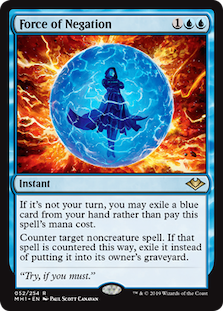 However, that dream scenario isn't probable. The deck has to mulligan very aggressively since most hands do nothing. The London mulligan makes it plausible to make it happen, to the point that I'm told it's the only reason Neoform combo is possible. However, it's still quite unlikely to come together.
However, that dream scenario isn't probable. The deck has to mulligan very aggressively since most hands do nothing. The London mulligan makes it plausible to make it happen, to the point that I'm told it's the only reason Neoform combo is possible. However, it's still quite unlikely to come together.
Even if Neoform finds the combo, the deck is very soft to interaction. From Thoughtseize to Thalia, Guardian of Thraben, anything that disrupts the carefully and precariously built engine makes the car explode. If you survive the first few turns against Neoform, you're unlikely to lose. In my opinion, it's just Modern's version of Legacy Belcher: a scary deck that either kills you before you move, or it just loses. Play a reasonable Modern deck that doesn't just goldfish, and you'll be fine.
The Other Glass Cannon
On a similar note, I haven't been impressed with Bant Infect so far. I've lost to it plenty of times, but it keeps feeling like it was a failure of my deck rather than anything the opponent did. I realize that many have always felt this way, but since Gitaxian Probe was banned, I feel like Infect needs to outplay me to win.
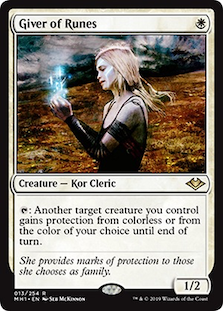 The Bant versions I've faced so far have been really clunky. They've gotten a lot of Oops, I Win! combinations, but if they don't come together they really struggle. Giver of Runes and Teferi, Time Raveler are great for forcing through an infector and Scale Up allows some truly out-of-nowhere wins. However, these cards are replacing the pump spells that infect still needs to assemble so it can secure victory. The move from UG to Bant Infect appears to have exacerbated the "wrong-half problem" the deck already had.
The Bant versions I've faced so far have been really clunky. They've gotten a lot of Oops, I Win! combinations, but if they don't come together they really struggle. Giver of Runes and Teferi, Time Raveler are great for forcing through an infector and Scale Up allows some truly out-of-nowhere wins. However, these cards are replacing the pump spells that infect still needs to assemble so it can secure victory. The move from UG to Bant Infect appears to have exacerbated the "wrong-half problem" the deck already had.
I've had plenty of games where Infect drew lots of protection and had the Scale Up kill, but never saw an infector. Other times they only got one infector and lost to a sweeper, Plague Engineer, or multiple removal spells. Sometimes, their only pump is Scale, and they only had a one-turn window to kill and couldn't. To me it looks like going Bant has exacerbated Infect's variance, and on net it's a negative for the deck.
Brewer's Format
Everyone is trying everything to see if anything sticks. Modern's received so many new cards, and they were only evaluated in the context of Hogaakvine. Everyone's playing catch-up now, and this means that brewers have the space to just go nuts.
For me, this means that this weekend will be very interesting. I expect to be surprised a lot and not see the same deck twice each round. On the one hand, the prospect is exciting. On the other, how do you prepare for the unexpected?
Reflections on a Mulligan
Finally, I need to address the elephant in the room. However, I don't really have an opinion on the London mulligan in practice. The Neoform players tell me their deck is only viable 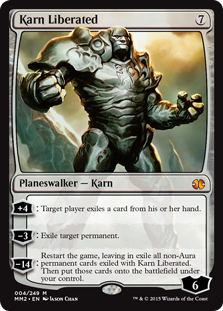 because of the London mulligan; theorists expect it to benefit less-than-fair strategies, and for it to have an overall negative impact on Modern. So far, I haven't seen any of that happening.
because of the London mulligan; theorists expect it to benefit less-than-fair strategies, and for it to have an overall negative impact on Modern. So far, I haven't seen any of that happening.
Now, I don't play decks that really benefit from the new mulligan. I swing between straight aggro to control, with a little Storm for spice. I don't need to mulligan for very specific cards all the time, so the new mulligan isn't really doing anything for me. Under the Vancouver rules I mulliganed roughly 1/3 of the time because I didn't have the right mix of lands and spells, and went to five or less once every ten mulligans or so. Over the past week I've recorded similar numbers. I'm not seeing any real difference in terms of playable hands.
Unforeseen Consequences
There have been a few problems that I didn't expect, and they make me question the longevity of this new mulligan. Problems within formats can theoretically be solved via bannings, but I'm seeing some structural problems with the mulligan itself. The first is the feel-bad aspect. Since you were drawing off the top and then scrying, there were limited opportunities to make a mistake. You either kept the scry or didn't based on the opening hand.
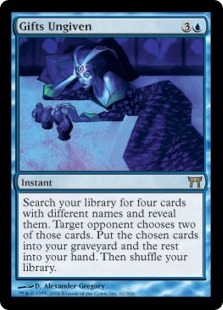 With London, it feels like you're making sacrifices. Frequently I and those I've spoken to have mulliganed into good seven-card hands, but once you start cutting cards they become unplayable. It feels worse when I London to five and and am left with a mediocre hand after choosing which cards to bottom rather than I opened a mediocre five. Then there are the times you bottom cards based on how you expect things to go, and they go a completely different direction, retrospectively making your mulligan decision bad. Again, I know that statistically and strategy-wise such a decision was good, but the loss feels worse.
With London, it feels like you're making sacrifices. Frequently I and those I've spoken to have mulliganed into good seven-card hands, but once you start cutting cards they become unplayable. It feels worse when I London to five and and am left with a mediocre hand after choosing which cards to bottom rather than I opened a mediocre five. Then there are the times you bottom cards based on how you expect things to go, and they go a completely different direction, retrospectively making your mulligan decision bad. Again, I know that statistically and strategy-wise such a decision was good, but the loss feels worse.
Then there's adjudication. I've seen several bitter disputes about how many mulligans players have taken escalate. Neither player wrote down how many mulligans they'd taken, and one or both lost track while drawing seven cards each time. This was rare with the Vancouver mulligan.
Several judges I know have admitted they're worried about cheating involving the mulligan, such as "forgetting" how many they'd taken or worse: deliberately writing down too many for the opponent and disputing it. In such a dispute the judges are forced to go with the better records, and they're worried that will lead to rewarding cheaters. Personally, I'll be more obsessive with my record keeping than normal this Saturday, but it is very concerning.
Bringing Everything Together
What all this means for me this weekend is that I'll need to really be watching my opponents. I'm naturally suspicious at GP's from experience, but now I'll really need to be careful. I also can't try to game the event as I've done in the past. As a result, it's best to go in with a proactive, disruptive deck so I'm not just dead to anything. And that sounds like familiar territory for me.



